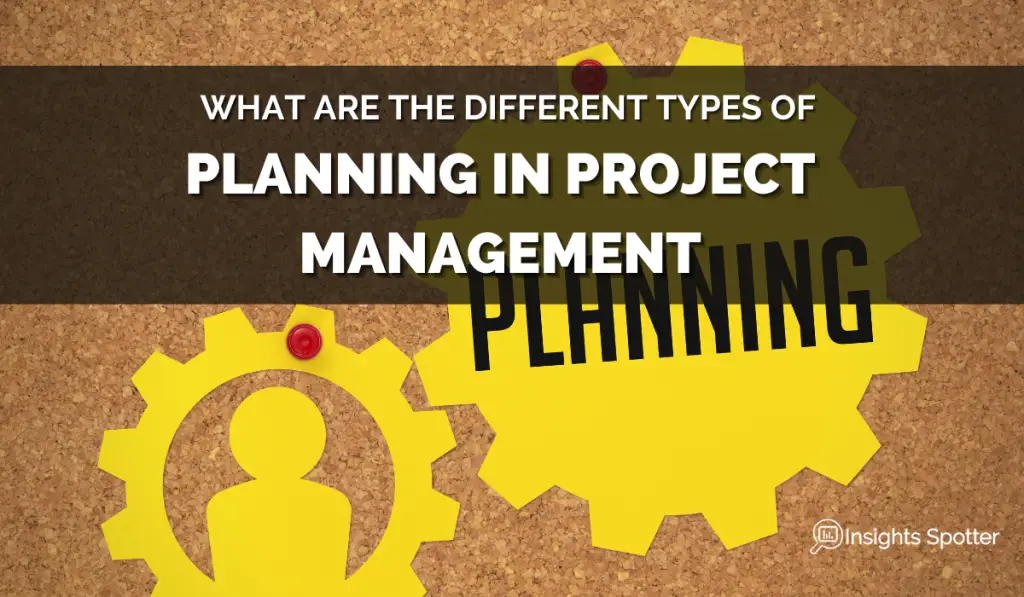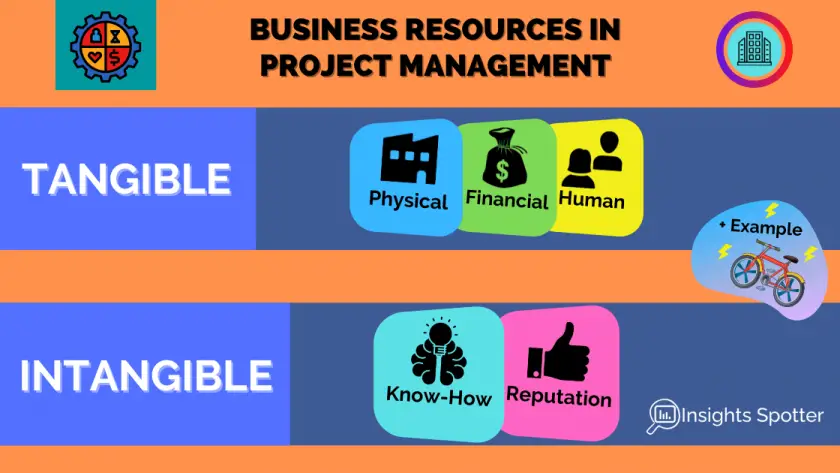What Business Resources Used In Project Management?
When you work as a project manager or business analyst, you need to understand business resources, which can be considered for the project. The company’s resources are what executives and project managers have to play with to achieve their objectives and develop a competitive edge through new initiatives.
| Resource Group | Resource Type | Resource Examples |
|---|---|---|
| Tangible |  Physical | ⋆ Buildings ⋆ Lands ⋆ Inventory Equipment |
| Tangible |  Financial | ⋆ Financial health ⋆ Cash flow ⋆ Credit |
| Tangible |  Human | ⋆ Staff & resources ⋆ Skills & expertise |
| Intangible |  Know-how | ⋆ Knowledge ⋆ Patents ⋆ Trademarks ⋆ Standards |
| Intangible |  Reputation | ⋆ Brand ⋆ Goodwill |
In the post, we will look into each type of resource in detail, and I will provide case study examples showing how understanding each resource affects decision-making. The information will highlight the organisation’s inherent internal strengths and weaknesses, and if resources are not utilised effectively. Therefore, the analysis results will make us aware of what we can leverage to succeed and what needs to be improved.
If you are interested in other strategic tools to understand the business and its environment better, check my blog post on MOST Analysis, PESTLE, SWOT or Porter’s Five Forces.
How To Use Business Resources in Project Management?
It would help if executives appreciated business capabilities before committing to new initiatives or making decisions as some resources may be a barrier for the organisation to move forward.
So, let’s understand how we can gain insights into the company’s capabilities by identifying and classifying organisation means. The above table splits resources into five essential business resources’ types by utilising strategic planning tool, Resource Audit.
If you are running a new project in the organisation, you have to understand the business capabilities because awareness will contribute to the project’s success. The manager can use the tool Resource Audit as a guide in the project process’s planning stages. The tool will highlight Physical, Financial, Capital, Know-How and Reputation resources Strengths and weaknesses. The manager then can utilise strengths or address weaknesses as risks or issues.
For example, if the result indicates a lack of know-how or you do not have enough staff, and you have that information at the planning stage, you can take appropriate actions early. You can communicate upfront to the business about additional budget needs and requirements to hire new individuals or train existing once. Thus, managing a business’s expectations and minimising noise and resistance in the future.
If analysis indicates that particular strength in reputation, you can prepare to leverage the brand in the testing and realisation stages. For example, you could use an interested customer base as a controlled group for testing. It is likely that if your reputation is excellent, your customer will want to help you.
Let’s have a look at our case study and business resources types. Plus, how that affects the project.
Business Resouces In Project Management Case Study “Two-Wheels”
Company Description
Bicycle manufacture with original name Two Wheels is a medium-sized business based in the EU. There are around 50 staff members, including engineers, administration and sales staff. It is leading in recreational and city bicycles in central EU. But they see electric bikes (e-bikes) gaining popularity and would like to keep with the trend. The aim is to build two prototypes in the next two years and later have a 65% automated robotics line to assemble these new bicycles in the future.
Worth to note that the business has a loyal customer base as it was operating multiple years in the past.
Project
The business has established a plan to address the increasing demand for electric bicycles. The project is at a planning stage. The project aims to build several prototypes and test them in the market.
Time to look into each type of resource and how it may affect our fictional business, Two Wheels.
What Are Physical Business Resources?
When asked to think about resources, probably, the first one that comes to mind is physical, tangible items that the organisation owns or have access to, for example, buildings, plant, inventory, equipment and land. It is not surprising because these are the once you can actually see and touch.
Most organisations would have a very clear understanding of their physical resources as you report on them in business accounts as assets, using to produce goods and do business. Plus, because when asking for financing, you can make evident to banks that you have enough assets to pay back the loans if things get tricky or get better terms.
Knowing that you have them might not be enough; you need to know their condition and need for business. Thus, it would help if you were considering age, conditions and business situation. When these resources’ properties are apparent, it is worth exploring if all of these resources are used effectively. But that could be a subjective decision by the business.
Physical Business Resources: Project Impact Example
Let’s have a look at our Two Wheels company’s situation. The company has one large factory, which it is using to construct conventional bicycles. It is fully utilised at the moment. So, if a business wants to start producing e-bikes, it may need to consider acquiring a new facility.
The company also have all the required equipment to build old-style bicycles. The same equipment can be used to create frames for new e-bikes. However, some additional solutions will need to be bought to introduce electric engine and battery. Plus, some of the existing equipment is getting outdated, so replacements will need to be included next year to maintain the production rate.
And you guessed it right! If building an e-bike and infrastructure is part of the project scope, multiple of these additional purchases could be in scope for a project manager that he/she needs to include in the plan.
What Are Financial Business Resources?
Needless to say, knowing financial resources are highly crucial for businesses for many reasons, like actual reporting requirements, cashflows, which is also called the blood of a company, and investments into other resources in our list.
Suppose, if your company operates in a more cyclical market, having a nice cushion of cash in the bank could help to weather storms in the market. Thus, a business needs to know the financial situation to have money at the right time.
However, cash is not the only thing you should be considering. You would also examine the organisation’s credit rating, access to funds, e.g. loan facility in the bank. If you have debtors or creditors, which most businesses have, you will also consider their management strategy and terms.
Like physical resources, organisations should be aware of their financial resources and ensure that capital allocation is optimal in trying to achieve goals.
If businesses are in operation now, they will have a relatively good understanding of their financial situation. If not, I am sure companies will find out quickly or go out of business.
Financial Business Resources: Project Impact Example
Our Two Wheels company has a relatively good capital structure, 90% equity and only 10% debt. However, the bank’s available money is only 450K, which is already excluding salaries for next month.
The project expects it will need a budget of 100K to build two prototypes. Furthermore, if these are successful, and the business decides to open a new production line, Two Wheels will need to invest an additional 1M. Thus, if they want to pursue the e-bike market, the total budget will be 1.1M.
Consequently, the company will need to borrow 650K, which would move the capital structure to 80% equity and 20% debt, increasing its risk. Still, they strongly consider continuing with the project and taking a chance as they do not want to be left behind in a new market.
The project manager will be dependent on business managers decisions to continue with the project as without a Financial capital very little can start. Also, the project team will need to keep an eye on project purchases to make sure they do not go over the budget. If there are some issues they will need to discuss with business managers immediately as financial resources are tight.
What Is Human as Business Resources?
Others say people are the biggest asset in the organisation, and they would be right! From building products to doing accounts, people are the once that push organisation forward.
There are countless things to consider here, and we will not cover them all in my short post. When you are completing your analysis, consider expertise, adaptability, commitment, culture fit and flexibility.
I like the way Jim Collins puts in his book Good to Great “First Who, Then What—get the right people on the bus.” The idea behind is that if you want to have a great company get great people first. Only then put them in the right spots in the organisation and let them shine. They will find a way to make the company great. Then top people attract other great people, and you set up an organisation for success. If you have not read the book yet, I highly recommend it.
One interesting idea is that money, not the best way to motivate individuals to perform at their best. So, what is?
The way to motivate people is to give them an exciting job—something they can own and see progress.
The task that is challenging enough but not unsurpassable for the level of skill gives a flow-like experience. Flow is a feeling that you get when the task is so interesting that you lose a sense of time or forget about your life problems. I am sure at one point in your life, you have felt that. If you manage to give such a task to your human resource, productivity will go through the roof.
I have learned about it in one great book called Flow: Living at the Peak of Your Abilities by Mihaly Csikszentmihalyi, PhD. The book goes into details about how to find those tasks that give fulfilment in life. If you have never tried listening for an audiobook or did not try audible, check out the link below, you can get 30 days for free and choose one book.
Human as Business Resources: Project Impact Example
Two Wheels have excellent engineers who have a good relationship with management and enjoy the work they do. However, they do not have many skills in constructing e-bikes. In particular, when it comes to electronic parts.
Thus, the project will have to spend some time to upskill some of the existing engineers who would like to learn electronic aspects of e-bikes. The company will still need to maintain the same production level in conventional bicycle manufacturing. Hence, the project will have to backfill those engineers who want to move to a new division. If not enough interest is generated inside the company project team would have to look for the right skills outside.
What Is Know-how or Expertise as Business Resource?
We are getting into the realms of intangible resources and looking into the industry’s collective business knowledge, markets, engineering solutions, etc. For example, the way technology can be used to enhance processes and improve the quality of products. Also, We can even consider notable trademarks, patents that the organisation owns or well-establish standards under Know-how.
Know-how as Business Resource: Project Impact Example
Two Wheels is famous for building highly durable but straightforward frames. Engineers in the company are highly proud of their welding abilities, and each part of the structure is thoroughly tested. Therefore, we see a know-how aspect in specific skill and knowledge of how to do excellent welding.
The project team feels very comfortable with the ability of the company to construct a sturdy e-bike. It may still require to enhance know-how on the electronic parts. Thus, the team may need to organise staff training as part of the project.
What Is Reputation as Business Resource?
They say it takes ten years to build a reputation and 10 seconds to destroy it. All companies are conscientious about this resource, which takes ages to build. Many companies spend thousands, if not millions, on advertising so the market can recognise the brand and hopefully associate it with quality. If people do so, they will be more willing to buy the product and pay a premium, a.k.a. Goodwill. A great example is Apple.
Reputation as Business Resources: Project Impact Example
Two Wheels company has a great brand of conventional city and recreational bicycles. Customers, in particular, think that products are very sturdy, durable and have high-quality materials.
The project will need to be careful when managing customer expectations, not to affect the brand’s quality. Two Wheels do not have experience in e-bikes, and initial products may have lower quality grade. Maybe the business will need to create prototypes under a different brand or company to ensure the main business is not affected.
Alternatively, provide excellent customer service when issues arise to show how much the business cares about its customers. Thus, maintaining a great brand and customer’s Goodwill, i.e. premiums.
Business Resouces In Project Management Conclusion
Analysing companies’ internal tangible and intangible resources and evaluating them will indicate their essential strengths and weaknesses. It should highlight where the business should use resources more effectively.
We have seen multiple examples where Two Wheels have strengths like branding and weaknesses like lack of electronics skills. The project will need to use strengths and mitigate weaknesses to succeed.
In the comments below, let me know if you plan to use companies resources or resource audit as a tool in your company analysis or next project.
Subscribe to our newsletter!
Latest Blog Posts
- Sustainable Project Management: Trends, Tools, & Strategies
- Unlocking Strategic Value: How NIST CSF 2.0 Shapes Project Choices for Better Outcomes
- Cybersecurity Project Management: Protecting Your Digital Frontier
- What are the Different Types of Planning in Project Management?

- Transforming Project Management with AI Software: Tools, Challenges, and Best Practices
- Unlocking the Benefits of AI-Powered Project Management


